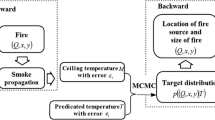Abstract
This study considers the development and evaluation of a prototype inverse fire model (IFM) aimed at predicting the heat release rate of a compartment fire using smoke layer information gained from building environmental sensors. The proposed methodology consists in: performing a search for the unknown heat release rate (HRR) by performing hundreds of different zone model simulations; comparing model predictions to observation data and thereby formulating an error function; using an optimization technique to minimize the error function and thereby producing a best estimate of HRR. The prototype IFM algorithm uses a zone fire model called BRI2002 (developed by the Building Research Institute in Japan) in conjunction with a genetic algorithm for optimization. The IFM algorithm is here applied to a reduced-scale laboratory experiment consisting of steady, over-ventilated, fire conditions in a simple multi-compartment (three rooms) configuration. The IFM algorithm is applied using a multiple-variable formulation in which both the fire size and the fire compartment venting conditions are assumed unknown, and using a one-observable or a two-observable scheme providing information on either the smoke layer temperature or on both the smoke layer temperature and depth. This framework is of particular interest because in the case of a one-observable scheme, the inverse fire problem is ill-posed, i.e. the optimization problem features multiple solutions and may converge to incorrect predictions of the fire size. This study shows that the two-observable scheme provides a way to regularize the inverse fire modeling problem, i.e. a way to provide a unique fire size solution. Our tests indicate that IFM-based estimates of HRR have an accuracy of better than 40%.















Similar content being viewed by others
References
Mandel J, Beezley JD (2008) Morphing ensemble kalman filter. Tellus A 60:131–140.
Mandel J, Bennethum LS, Beezley JD, Coen JL, Douglas CC, Kim M, Vodacek A (2008) A wildland fire model with data assimilation. Math Comput Simul 79:584–606.
Mandel J, Beezley JD, Kochanski AK (2011) Coupled atmosphere-wildland fire modeling with WRF 3.3 and SFIRE 2011. Geosci Model Dev 4:591–610.
Rochoux MC, Delmotte B, Cuenot B, Ricci S, Trouvé A (2013) Regional-scale simulations of wildland fire spread informed by real-time flame front observations. Proc Combust Inst 34:2641–2647.
Rochoux MC, Emery C, Ricci S, Cuenot B, Trouvé A (2014) Towards predictive simulation of wildfire spread at regional scale using ensemble-based data assimilation to correct the fire front position. In: Fire safety science—proceedings. Eleventh international symposium, international association for fire safety science, (accepted for publication).
Rochoux MC, Ricci S, Lucor D, Cuenot B, Trouvé A (2014) Towards predictive data-driven simulations of wildfire spread. Part I: reduced-cost ensemble Kalman filter based on a polynomial chaos surrogate model for parameter estimation. Nat Hazards Earth Syst Sci 14:2951-2973.
Rochoux MC, Emery C, Ricci S, Cuenot B, Trouvé A (2015) Towards predictive data-driven simulations of wildfire spread. Part II: ensemble Kalman filter for the state estimation of a front-tracking simulator of wildfire spread. Nat Hazards Earth Syst Sci 15:1721–1739.
Rios O, Jahn W, Rein G (2014) Forecasting wind-driven wildfires using an inverse modelling approach. Nat Hazards Earth Syst Sci 14:1491–1503.
Richards RF, Munk BN, Plumb OA (1997) Fire detection, location and heat release rate through inverse problem solution. Part I: theory. Fire Safety J 28:323–350.
Richards RF, Ribail RT, Bakkom AW, Plumb OA (1997) Fire detection, location and heat release rate through inverse problem solution. Part II: experiment. Fire Safety J 28:351–378.
Davis WD, Forney GP (2001) Sensor-driven fire model version 1.1. National Institute of Standards and Technology, Report NISTIR 6705.
Lee W-S, Lee S-K (2005) The estimation of fire location and heat release rate by using sequential inverse method. J Chin Soc Mech Eng 26:201–207.
Neviackas A, Trouvé A (2007) Sensor-driven inverse zone modeling of enclosure fire dynamics. In: SFPE Professional Development Conference and Exposition, Las Vegas.
Leblanc M, Trouvé A (2009) Inverse zone modeling of enclosure fire dynamics. In: 6th U.S. Combustion Meeting, Ann Arbor.
Koo S-H, Fraser-Mitchell J, Welch S (2010) Sensor-steered fire simulation. Fire Safety J 45:193–205.
Cowlard A, Jahn W, Abecassis-Empis C, Rein G, Torero JL (2010) Sensor assisted fire fighting. Fire Technol 46:719–741.
Jahn W, Rein G, Torero JL (2011) Forecasting fire growth using an inverse zone modeling approach. Fire Safety J 46:81–88.
Jahn W, Rein G, Torero JL (2012) Forecasting fire dynamics using inverse computational fluid dynamics and tangent linearisation. Adv Eng Softw 47:114–126.
Overholt KJ, Ezekoye OA (2012) Characterizing heat release rates using an inverse fire modeling technique. Fire Technol 48:893–909.
Beji T, Verstockt S, Van de Walle R, Merci B (2014) On the use of real-time video to forecast fire growth in enclosures. Fire Technol 50:1021–1040.
Tanaka T, Yamada S (2004) BRI2002: two layer zone smoke transport model. Fire Sci Technol 23:1–131.
Houck CR, Joines JA, Kay MG (1995) A genetic algorithm for function optimization: a Matlab implementation, Report NCSU-IE TR 95-09, North Carolina State University. www.ise.ncsu.edu/mirage/GAToolBox/gaot/.
Lautenberger C, Rein G, Fernandez-Pello C (2006) The application of a genetic algorithm to estimate material properties for fire modeling from bench-scale fire test data. Fire Safety J 41:204–214.
Rein G, Lautenberger C, Fernandez-Pello C, Torero JL, Urban DL (2006) Application of genetic algorithms and thermogravimetry to determine the kinetics of polyurethane foam in smoldering combustion. Combust Flame 146:95–108.
GNU Octave. http://www.gnu.org/software/octave/.
National Fire Protection Association (2012). Standard for smoke control systems. In: NFPA 92, vol 92, pp 12–13.
Author information
Authors and Affiliations
Corresponding author
Rights and permissions
About this article
Cite this article
Price, M., Marshall, A. & Trouvé, A. A Multi-observable Approach to Address the Ill-Posed Nature of Inverse Fire Modeling Problems. Fire Technol 52, 1779–1797 (2016). https://doi.org/10.1007/s10694-015-0541-7
Received:
Accepted:
Published:
Issue Date:
DOI: https://doi.org/10.1007/s10694-015-0541-7




